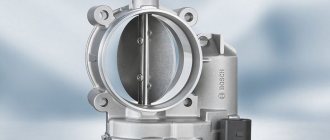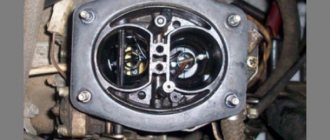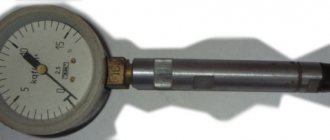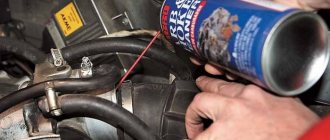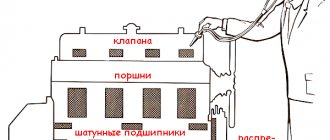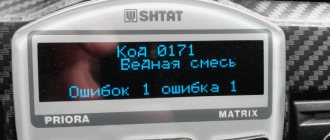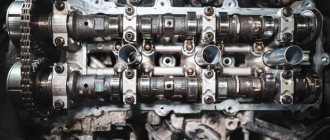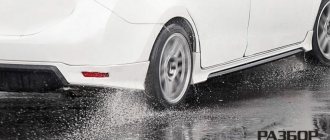What is
When they say that the gas pedal is falling, this means a short-term loss of vehicle traction. The pedal simply does not respond to the driver's actions at the right time. The situation is not entirely critical, except in cases where it is necessary to add gas to avoid a traffic accident. When diagnosing a problem, the first step is to determine the type of failure. Here drivers identify the following types of failures:
- Short-term for 2-3 seconds, a dip occurs when you sharply press the gas pedal.
- Regular twitching, expressed in a series of jerks.
- Deep. They last up to 10 seconds.
- A series of dips or jerks where the vehicle changes its speed regardless of the pedal.
Why are the revs dropping?
Cases in which dips appear when you sharply press the gas are represented by incorrect operation of components in the car's power systems. Most problems occur on cars with carburetors. But even on injection models such cases are not excluded.
If there is a drop in speed when pressing the pedal vigorously, you need to inspect the accelerator pump. Most likely it is faulty. It is possible that the liquid content in the fuel level stabilization chamber has decreased. The problem manifests itself at the beginning of movement, at zero load, and when driving with a change of speed.
How to fix:
- Monitoring of the fuel supply system in the carburetor is required. Pay attention to the following components - atomizer, channels, inspect the valves, diaphragm.
- The filter element located at the inlet is checked. The appearance of dirt and blockages interferes with the flow of fuel, which is accompanied by a drop in the level in the stabilization chamber. After cleaning the filter, you can resume system operation.
- If there are blockages, it is recommended to pay attention to the fuel pump filter, fine filter and the filter element on the fuel intake in the tank.
It is advisable to examine the entire fuel system, excluding malfunctions and blockages.
Reasons for constant failures
While operating a car, it is easy to detect other signs and reasons why failure occurs when you press the gas pedal.
Common situations:
- Short-term jerks that appear under moderate load, when the car starts moving or at idle. The reason is related to the 1st chamber, where the outlet holes become clogged; problems with the accelerator pump are possible.
- Longer breaks, sometimes combined or turning into twitching. Noticeable when lightly accelerating, when the car is traveling at low or medium speed. If the signs disappear with active gas operation, it means there is a problem with the nozzle - it is clogged or not fully closed. It is possible that the elements of the dosing system may become clogged. You should be wary of a mismatch in the markings of the fuel nozzle, the possibility of air masses entering from the outside, or a drop in the amount of fuel in the float chamber.
- If, when you press the gas pedal, the drop in speed becomes regular, there is instability at zero load, swaying, signs indicate problems with the jet, CXX, EPH channels.
- Lack of response under heavy loads, when operation is noted with open throttle valves of the 1st and 2nd chambers. All this is accompanied by a drop in potential and pickup capacity. Such problems occur due to incorrect operation of the ecostat, problems with fuel due to interruptions, or clogging of gasoline supply units. There is a high probability of problems with the power mode economizer.
The functionality of the accelerator pump requires increased attention in most situations, because it is indispensable in the operation of the carburetor and power unit in all modes, in addition to idling.
Possible reasons
Several parts can be the source of this problem. In carbureted cars, a common culprit is the carburetor itself. It is recommended to configure it.
Also be sure to check the spark plugs. They should not have heavy carbon deposits or visible defects. Also inspect the wiring. On carburetor and diesel vehicles, we recommend additionally checking the following components:
- fuel distribution system. Clogged jets cause jerks and dips when you press the gas sharply;
- injector;
- electronic fuel supply system;
In modern foreign cars, the on-board computer often causes failures. Here you should carry out computer diagnostics in a specialized service.
How to get rid of problems caused by a drop in speed
A failure in the engine during significant acceleration can occur for various reasons - this has already been dealt with. These reasons vary depending on what type of engine is installed in the car: carburetor or injection. Accordingly, methods for troubleshooting also vary. We have to deal with this now.
Checking the carburetor system
Initially, the operation of the fuel system is checked to see how smoothly and correctly it works. Every working unit and detail matters. Air leaks are checked, fuel lines are examined and the fuel pump is diagnosed. All blockages and deposits are removed.
Fuel pump
If the diagnostics do not reveal any problems, then the carburetor may cause a failure in the engine when the gas pedal is pressed. This part is responsible for supplying fuel. During normal operation of the carburetor, fuel is supplied without interruption, constantly and evenly.
To identify and eliminate the cause of the problem, you must proceed as follows:
- We exclude air leaks, which may occur due to a loose fastening on the exhaust manifold.
- We study the condition of the mesh-type filter, which is located in the area where the pipe from the fuel pump connects.
- We dismantle the EPH valve and the sealing ring and examine their condition. If the EPHH is working properly, then when you connect one side of the wire to the terminal, and the opposite end to the positive terminal of the battery, a clicking sound will be heard.
- Check the liquid level in the float chamber. To do this, start the engine, leave it to run for a while, remove the top carburetor cover and filter housing. Now let's evaluate the fuel level. In normal condition, it should be in the middle of the inclined wall.
- The dosing system may become clogged and this is a common problem. To eliminate it, you will need to remove the top part of the dispenser and the jets. We look for blockages and remove them using wooden parts. Emulsion tubes, which are often forgotten, also need inspection and maintenance.
- Special products are used to clean the carburetor channels.
Drop in speed on injection models
In the case of injection cars, when failures occur in the engine, the fuel supply system is first checked to see how well this system works. What you need to pay priority attention to:
- Is there a blockage on the fine filter?
- The fuel pump operates stably.
- Clean filter mesh on the intake.
- Is the fuel rail pressure normal? The norm for this indicator starts from 2.8 and reaches 3.2 Bar.
- The sensors that regulate the formation and supply of the fuel mixture are functioning normally.
- How many errors have accumulated in the ECU?
- The throttle valve has collected debris.
- Injectors can cause failures in the operation of an injection engine when you press the gas pedal. We definitely check their functionality.
To carry out a complete diagnosis with your own hands, you need a multimeter and a pressure gauge. Some working components (injectors, throttle valve, ECU) can only be checked by specialists. If the cause has not been identified, then you need to check the ignition system. First of all, pay attention to the spark plugs. Then the wiring, main operating components and the installation itself are checked.
Do not delay in solving the problem. It will not go away on its own, the situation will only get worse. Ultimately, more serious problems with the vehicle may arise that will take longer and be more expensive to fix. Moreover, the risk of accidents increases significantly. But you cannot skimp on safety; not only your life is at risk, but also that of other road users.
Difficulties when accelerating a car
The problem may only appear when accelerating the car. There are a number of steps to follow to help diagnose the source of the problem. If you have fairly advanced repair skills, then we recommend following these steps:
- As stated earlier, start your inspection with the spark plugs. Check the integrity of high-voltage wires.
- If everything is in order, we move on to the throttle. Its clogging can cause the engine to respond untimely to the driver’s actions.
- Be sure to inspect the air filter in the engine compartment. It is recommended to replace it every 10-15 thousand kilometers.
- Inspect the fuel filter for wear and replace it if necessary.
- Clean the injectors.
If all these actions do not produce results, then the malfunction is caused by the electronic control unit. Here you cannot do without the help of highly qualified specialists.
Dips at idle
To identify the cause, you can add to the steps already described above an inspection of the fuel pump for structural defects, as well as diagnostics of the idle speed sensor. When replacing spark plugs, buy a complete set. We also recommend ordering products that are created specifically for your make and model of car. Installing low-quality candles can lead to adverse consequences.
Some cars are equipped with a special mass fuel flow sensor. Its breakdown is a rare occurrence, but often it is the source of failures. It is also worth diagnosing the correctness of the throttle position sensor. It is these electronic devices that are responsible for forming a portion of air that enters the cylinder. If you have access to these sensors, first we recommend simply cleaning the contacts to remove any blockages.
Dips at high speeds
I don’t know how to explain it, at XX rpm, if you press the pedal to the floor, then the engine seems to be running smoothly, there is no tachometer, there is no way to check at what rpm. Diagnostics says 0000. What is this MAF, spark plugs, lambda??? Where to start where to climb???
You mean at idle? Without load and to the floor? What, did you check for the cutoff?
Nissan Sunny 1998 FB15 QG15
Nissan Sunny 2003, QG15, FB15 (sold)
New Sanya Poddubny :))))
Nissan Primera Wagon 2001 2.0 CVT QR20DE
Message from
v_OFF_kaYou mean at idle? Without load and to the floor? What, did you check for the cutoff?
Yes, without load, what does cutoff mean? Is this how it should be? I'll check the spark plugs.
Message from
DeleTYes, without load, what does cutoff mean?
https://reviews.drom.ru/toyota/sprinter/11441/ read here, and don’t do that again))
Nissan Sunny 1998 FB15 QG15
Message from
v_OFF_kaI'm already reading and laughing
Sunny 1.5/2000Singapore. QG15 FB15.Gas-Petrol “” Prepare Sunny in the summer “”
Message from
DeleTYes, without load, what does cutoff mean? Is this how it should be? I'll check the spark plugs.
Yes, everything is normal for you, you don’t need to check the spark plugs, otherwise you’ll tear off the bushings on the mounting bolts of the coils, there are such craftsmen.....
Last edited by gert3; 04/23/2009 at 12:39 pm.
Elegant Czech barn, Nissan-“Argamak” FNB-15 4WD, 05.99
gert3
Thanks, reassured me!!! So I definitely won’t climb, I’ve already climbed once, that’s enough!!!!
[QUOTE=v_OFF_ka;1072046654]https://reviews.drom.ru/toyota/sprinter/11441/ I haven’t laughed so hard in a long time!!!
Nissan Sunny 2003, QG15, FB15 (sold)
Engine tripping
This problem is a fairly common cause of pedal failure. This term means that one or even several cylinders in the engine are not working, which is extremely dangerous for the engine and can also cause pedal failure when driving. An experienced motorist can easily determine by ear whether the engine is stalling. Beginners can be guided by the following signs:
- Poor acceleration even at high speeds.
- Slight engine shaking.
- Noticeably higher fuel consumption.
- The formation of dark spots on one or more candles.
To determine which cylinder specifically has failed, it is necessary to disconnect the high-voltage cable one by one. Be extremely careful if you perform this procedure yourself. There is a risk of electric shock. After this, the engine speed increases to one and a half thousand. If the sound does not change, it means you have removed the working cylinder. The wire is returned to its place, and then another is removed. Oxidation of the contact in a high-voltage wire often occurs. Diagnostics can be carried out using a conventional multimeter.
Dips when pressing the gas pedal Lada Kalina: acceleration and idling
What is "failure"? This is an effect in which the car does not accelerate when you press the gas pedal. Usually the failure lasts a few seconds, and then the “jerk” effect occurs. This is a fairly common malfunction associated with the fuel injection system. On Kalina, it does not occur often, but it does happen.
Video about gas failures on an injection engine:
This video material will talk about such a malfunction as gas leaks, the causes of occurrence, methods of elimination, and also contains some recommendations for car owners.
Causes of the phenomenon
Drop in speed and failure of the gas pedal
There are few reasons for the phenomenon of “failure” when pressing the gas pedal. It often appears after unsuccessful engine chip tuning and is accompanied by an increase in fuel consumption, but there are other problems directly with injection.
So, let’s look at the main reasons for the “failure” effect:
- Injectors. The fuel distribution system directly affects engine performance.
Clogged injectors
- Damage to the injector.
- The fuel supply system has failed .
- engine temperature and mixture enrichment sensors
- Errors in the electronic engine control unit.
Identifying and eliminating ECU errors
- Spark plug. This is the most common cause of accelerator pedal failure.
Condition of the candles. On the left the mixture is too rich, on the right it is too lean.
These are all the main reasons that can lead to gas pedal failure.
Dips during acceleration
Once the causes are considered, we can consider how to deal with the problem. So, let’s describe step by step what needs to be done when the gas pedal has dips during acceleration:
- The first step is to check the spark plugs. The appearance of carbon deposits or spark plugs that are too clean indicate that the mixture is not adjusted correctly. It is worth adjusting the correct amount of fuel mixture.
- Ignition wires can also cause the vehicle to malfunction.
- A clogged throttle can lead to failures during acceleration.
- The condition of the air filter affects the formation of the mixture, so it is worth changing it on time.
Air filter clogged
- The fuel pump (main faults), as well as the condition of the fuel filter, can affect injection. Therefore, in case of failures, it is necessary to diagnose them. To diagnose, you need to remove the fuel pump and check its operation, as well as the condition of the mesh filter.
Dirty fuel filter
Dirty fuel filter
- ECU errors can also lead to accelerator failures.
- The last reason is clogged injectors. They need to carry out diagnostics, check functionality, and also clean and replace faulty elements.
Thus, the causes of failures during overclocking have been identified and can be eliminated.
Gas leaks at idle
At idle, there are fewer reasons for failures, but they will have to be eliminated, since the car simply will not start normally, or stall after starting the engine. So, let's look at the work plan step by step:
- Checking the spark plugs. If the element fails, it is necessary to replace it.
Attention! It is recommended to change all four spark plugs to ensure smooth engine operation. Before installation, you should adjust the gap using a feeler gauge, which should be 1 mm for 92 gasoline.
Checking and adjusting the spark plug gap using a feeler gauge
- We change the fuel filter, it is located under the bottom of the tank, and also carry out diagnostics on the fuel pump. If malfunctions are identified, they should be eliminated.
Clogged filter in the gasoline pump
- We check the functionality of the idle speed sensor and cooling temperature.
- Fuel quality and clogged injectors also affect idle failures.
- Errors in the ECU can also cause this phenomenon.
- The performance of the injector directly affects the performance of the engine.
All these reasons can cause dips to appear at idle (more precisely, when switching from idle to driving mode).
conclusions
The main cause of failures are spark plugs, but they are not the only ones that influence the appearance of this effect. Some car enthusiasts may not be able to cope with the occurrence of such malfunctions on their own, and it is necessary to go to a car service center, where they will carry out high-quality diagnostics and also fix the problem. But it is worth considering that you will have to be generous, since neither computer diagnostics nor repairs will cost a penny.
carfrance.ru
